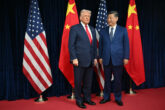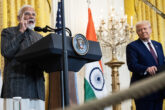April 25, 2019
Don’t be Fooled by China’s Belt and Road Rebrand
This is a pivotal week for China as President Xi Jinping welcomes roughly 40 world leaders to Beijing to participate in the second Belt and Road forum. The Belt and Road, Xi’s sweepingly ambitious vision for a world brought together by a web of Chinese-funded physical and digital infrastructure, has recently come under increased pressure. From Ecuador to the Maldives and beyond, a growing set of countries are voicing concerns about the downsides of Chinese investment. And democracies wary of China’s geopolitical ambitions, including the United States, have begun to offer alternatives to Xi’s signature initiative.
When initially unveiled in 2013, the Belt and Road met with a warm reception across large parts of the globe. For many developing countries eager for new sources of investment, it held significant appeal. Yet the reality of the Belt and Road has differed sharply from the beneficent vision advanced by Beijing.
The Belt and Road is fundamentally a geopolitical enterprise. If the United States fails to rise to the challenge, it will be one step closer to a 21st century defined by Beijing.
In fact, Chinese infrastructure projects pose up to seven challenges to recipient states. These challenges include erosion of national sovereignty; lack of transparency; unsustainable financial burdens; disengagement from local economic needs; geopolitical risks; negative environmental impacts; and significant potential for corruption.
High-profile Belt and Road cases such as the Hambantota Port in Sri Lanka exhibit many of these challenges, but so do less-well-known Chinese projects. A recent CNAS report examining ten Chinese projects spanning much of the world found that every project generated at least three challenges for the host country. Typically, the number of challenges associated with a project was higher the poorer and less capable the recipient state.
As Beijing hosts the next Belt and Road forum, it is fully aware that President Xi’s initiative has become tarnished. China will try to use the forum to rebrand the Belt and Road, for example, by announcing a new commitment to environmentally-friendly investments and sustainable financing. Beijing may also seek to formally designate which projects fall under the Belt and Road, which until now has served as a flexible – and loosely-defined – umbrella for its economic statecraft.
The world should not be fooled. Once the pomp of the forum dissipates, China’s promises and pledges will remain just that. Rather than meaningful change, excluding certain projects from the Belt and Road is simply a whitewashing exercise.
China could take actions to demonstrate its seriousness to reform the Belt and Road. It could terminate projects that have generated significant challenges for recipient states. Beijing could also forgive loans incurred by countries that are now in a position of long-term debt dependency. In addition, China could reduce its ownership of key projects below 50 percent by bringing in international partners recognized for their commitment to high-quality infrastructure.
But don’t hold your breath: China is unlikely to take any of these actions. Many of the challenges for recipient states associated with the Belt and Road translate into leverage for Beijing. Cancelling projects, debt forgiveness, and accepting a minority stake would all diminish the Belt and Road’s value as a tool for advancing China’s global influence.
As the Belt and Road forum convenes, it will be tempting for U.S. leaders to focus solely on amplifying growing international concerns about the downsides of Chinese infrastructure projects. American officials should not hesitate to call Beijing out for the gap between its Belt and Road rhetoric and the often troubling, on-the-ground reality.
However, this critique may prove unpersuasive if not paired with a positive vision for infrastructure connectivity. U.S. leaders should clearly articulate what high-quality looks like in practice – projects that are sovereignty-upholding, transparent, financially sustainable, locally engaged, geopolitically prudent, environmentally sustainable, and corruption resistant.
Ultimately, American actions matters more than words. Since 2018, the United States has launched initiatives centered on energy and digital connectivity, built capacity in countries receiving Chinese investment, and enacted legislation to stand up a new Development Finance Corporation. This is a strong start, but given the scope and scale of the Belt and Road, the United States will have to significantly up its game, for example, by unveiling a new digital development fund to support information connectivity projects in the developing world.
The Belt and Road is fundamentally a geopolitical enterprise. If the United States fails to rise to the challenge, it will be one step closer to a 21st century defined by Beijing.
Dr. Daniel Kliman is a Senior Fellow and Acting Program Director with the Asia-Pacific Security Program at the Center for a New American Security (CNAS). He recently co-authored a major CNAS report, “Grading China’s Belt and Road.”
More from CNAS
-
Indo-Pacific Security / Energy, Economics & Security
How to Win the Economic War with ChinaTrump's approach to China has run aground, giving Beijing unprecedented advantage in the economic conflict....
By Edward Fishman & Julian Gewirtz
-
America’s Self-Loathing Is a Losing Hand
This article was originally published in The Washington Post.Around 10 years ago, the United States began a historic shift in its grand strategy toward China, abandoning the b...
By David Feith
-
Indo-Pacific Security / Energy, Economics & Security / Technology & National Security
Selling AI Chips Won’t Keep China Hooked on U.S. TechnologyU.S. policy should not rest on the illusion that selling chips can trap China inside the American tech ecosystem....
By Janet Egan
-
Will New Delhi-Beijing Move Beyond Friction Points? | Ex-White Official On India-China Reset
Prime Minister Narendra Modi on Friday said that India and China, as two major economies, must work together to bring stability to the global economic order. NDTV's Gaurie Dwi...
By Lisa Curtis




